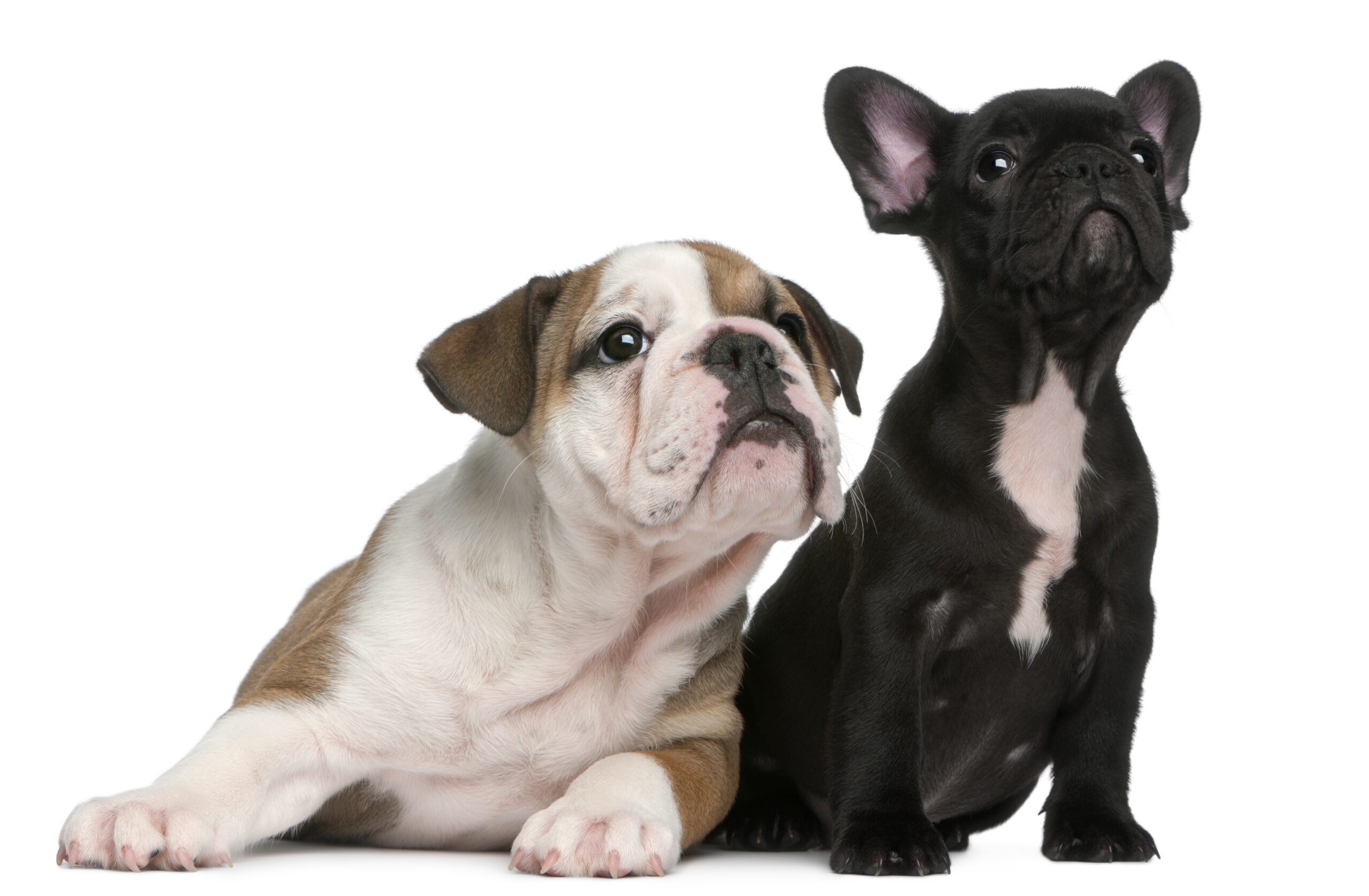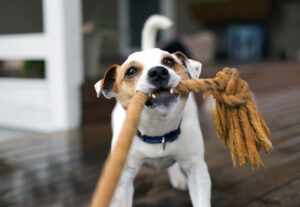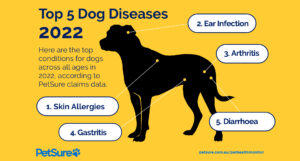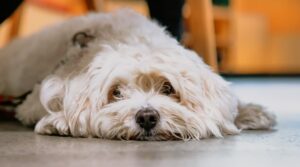French Bulldog | Traits | training | Typical health problems
This section outlines French Bulldogs traits, training and typical health problems.
French Bulldog | Breed highlights
| Breed: | French Bulldogs are a small companion dog breed. They have defining features such as their bat-like ears, flat faces, and facial wrinkles. |
| Coat type: | French Bulldogs have short, fine fur and a smooth coat which sits close to the skin. |
| Shedding: | French Bulldogs shed minimally; however, twice a year, they shed a lot more due to seasonal changes (Spring and Autumn). |
| Grooming: | French Bulldogs need weekly brushing and gentle cleaning around face folds. Bathing is required every few months. |
| Activity level: | Low to moderate – a short daily walk will meet exercise and social needs.. |
| Apartment friendly: | Yes |
| Small children: | French Bulldogs have a sweet and gentle temperament and are good around children (supervision is always recommended). |
| Other dog friendly: | French Bulldogs are considered non-aggressive and are generally friendly towards other dogs. |
What type of breed is a French Bulldog ?
French Bulldogs, or Frenchies as they are also known, are a top-ranking dog breed, particularly among city apartment dwellers. As pets, they are playful and have an easy-going temperament. French Bulldogs are a non-sporting dog breed type.
History of the breed
French Bulldogs – perhaps unsurprisingly – have quite a colourful history. The breed – a cross between Toy English Bulldogs (a now-extinct breed), Terriers and Pugs – originated in England but settled on French shores after being brought to the country by British lacemakers in the late 1800s. French Bulldogs from this era worked in factories alongside their lace-making owners, keeping significant rat populations at bay. Industrialisation brought French Bulldogs and their owners to Paris, where the breed, despite its quirky appearance, quickly captured the hearts of the Parisian fashion set. To this day, French Bulldogs are seen most often on the streets of the world’s style capitals, where they are seemingly most at home.
French Bulldog appearance and characteristics
French Bulldogs are short, stocky dogs that stand between 27 and 33 centimetres and weigh between eight and 12 kilograms. They come in various colours, including fawn, black, cream, blue (a soft or dark grey) and brindle and are recognisable by their high-pointed ears, short fur and facial wrinkles.
French Bulldogs are a brachycephalic (flat-faced) breed. Brachycephalic dog breeds have been bred with shorter, broader skulls – leading to the appearance of a flattened snout. Although loved for their squished faces, brachycephalic breeds, French Bulldogs, can experience a number n of complicated health problems. Breathing conditions related to the airways are common. French Bulldogs may also suffer from Brachycephalic Obstructive Airway Syndrome (BOAS) , which can affect lifelong breathing issues – snoring and snorting may indicate the presence of this condition – and are prone to respiratory diseases.
Other problems related to brachycephaly include eye conditions, skin conditions, anal gland problems, digestive diseases, ear infections and patella luxation (dislocation of the kneecap).
French Bulldog personality and temperament
French Bulldogs make natural companions and love nothing more than the company of people. This breed is considered playful, agreeable, calm, charming and of course, sweet-natured. French Bulldogs are also generally very responsive to obedience training, but it is worth noting they can be stubborn. A consistent, patient and early approach, like puppy preschool, will result in a more socialised and well-behaved dog.
French Bulldog traits
French Bulldogs adapt well to different settings and can get along with families with small children or adjust to apartment living. As a highly social dog, French Bulldogs like the company of others. Although they can tolerate short periods alone, the breed can become anxious if left alone for hours on end.
Those considering adding a Frenchie to their household should also factor in time for daily exercise. French Bulldogs may be a small breed, but they need a daily walking routine of at least 30 minutes. In addition, playtime that includes other dogs is great for their well-being and general social needs.
Note: as a brachycephalic breed, some can suffer from breathing problems, and hot or humid weather can worsen these. Heatstroke and heat stress can result from being unable to breathe correctly to cool down.
French Bulldog Lifespan
French Bulldogs have a lifespan of between 10 to 14 years.
The dos and don’ts of caring for a French Bulldog
Do: French Bulldogs are a low-shedding breed. However, weekly brushing is recommended to remove excess fur.
Don’t: Don’t over-bathe your French Bulldog. Bathing is only required around five to six times a year. Overbathing can strip the fur of natural oils that keep the coat and skin healthy. Do: Create a weekly grooming routine that includes the cleaning and drying of skin folds (wrinkles) around the face and anus. This area is susceptible to infection, so maintenance is essential. Other at-home health checks include ear, paw, claw, and tick checks. Check out PetSure’s Masterclass series for the latest how-to guides.
Common conditions for French Bulldog
| Conditions | Symptoms can include~ | Highest cost for a single treatment* |
| Brachycephalic airway disease | · Snoring or other noisy breathing · Coughing, gagging, retching and/or regurgitation/vomiting · Tire easily with exercise · Overheating, collapse, death | $22,722 |
| Skin Conditions including – infections and allergic skin disorder | · Scratching, biting or rubbing the skin · Signs of irritation including red skin, scabs, bleeding, pustules or weeping · Hair loss, flaky skin, texture changes, lumps or an unusual or unpleasant smell | $11,872 |
| Gastrointestinal (tummy) problems | · Diarrhoea, vomiting or constipation. · Blood or mucous in stool/vomit. · Increased frequency/urgency passing stool. · Weight loss. · Loss of appetite and interest in food. · May seem more tired than usual. | $12,028 |
| Ear Conditions –including infections and allergies | · Scratching, rubbing, or pawing at one of both ears. · Head shaking · Odour or discharge from the ears · Ears may be red or warm to the touch | $16,671 |
| Eye conditions (including corneal ulcers, uveitis, keratitis | · Squinting, redness, and ocular discharge · Rubbing or pawing at the eyes/face Colour changes to the eye or surrounding tissues | $3,885 |
Disclaimer: Reimbursement for these claims would be subject to limits, such as annual benefit limits or sub-limits, benefit percentage, applicable waiting periods and any applicable excess. Cover is subject to the policy terms and conditions. You should consider the relevant Product Disclosure Statement or policy wording available from the relevant provider.
* Please note that the values calculated are based on all claims for that condition and medically related conditions in each calendar year.
Types of pet insurance from PetSure
| Policy type | Policy description |
| Accidents | This product provides cover for specified accidental injuries up to an annual policy limit. Most policies will reimburse a stated Benefit Percentage that is typically 80% of eligible vet bills. Some condition sub-limits may also apply, with all annual limits resetting each year when the policy is renewed. It’s important to know that only defined accidents as listed in the policy’s Product Disclosure Statement will be covered (other conditions will not be covered). More information on what is typically covered and not covered in our find a policy page. |
| Basic care | This product provides limited cover for both specified accidental injuries and illness conditions, with a stated Benefit Percentage that can range from 60-90%. Treatments and medications for eligible conditions are typically covered subject to the applicable policy limits. Claimable conditions have an annual condition limit , meaning once the condition limit (subject to the annual benefit limit) has been reached in an annual policy period, costs relating to that condition will need to be covered entirely by the policyholder. However, annual benefit limits and applicable annual condition limits reset on renewal each year. More information on what is typically covered and not covered in our find a policy page. |
| Comprehensive / Accident and Illness | This product provides comprehensive cover for both specified accidental injuries and illness conditions, with a stated Benefit Percentage that will typically range from 70-85%. You can claim up to an annual maximum limit each year, which resets on renewal. Sub-limits for certain items may also apply. More information on what is typically covered and not covered in our find a policy page. |
Insurance products are issued by The Hollard Insurance Company Pty Ltd ABN 78 090 584 473, AFSL 241436 (Hollard) and/or PetSure (Australia) Pty Ltd ABN 95 075 949 923, AFSL 420183 (PetSure) (from 8 May 2023 only), administered by PetSure and promoted and distributed through their authorised representatives and distribution partners.
Any advice provided is general only and does not take into account your individual objectives, financial situation or needs. Cover is subject to the policy terms and conditions. Please consider the Product Disclosure Statement (PDS) to ensure this product meets your needs before purchasing, or choosing to continue with the product. PDS and Target Market Determination available on our partners’ websites. Meet our partners at petsure.com.au/partners.
Pet insurance can help by covering a portion of the eligible vet bill if the unexpected happens. Because it is difficult to predict the costs of veterinary care, it can help to have measures in place to help prepare for the unexpected. Check out our partner network and explore our policy tools to find a pet insurance policy.
Not all conditions or items are covered by Pet Insurance. Refer to the applicable Product Disclosure Statement for information about coverage and exclusions.
Frequently Asked Questions
French Bulldogs, as a flatter-faced breed, are vulnerable to certain conditions; ask a breeder whether there is a known history of the following:
· Brachycephalic Obstructive Airway Syndrome (BOAS)
· Eye conditions
· Teeth and gum problems
· Atopic Dermatitis
Also, remember to ask a reputable breeder for details relating to vaccinations and about official health checks carried out on the parents (checks should include tests for eye conditions, hip issues (dysplasia), and genetic spinal deformities). Finally, consider an independent veterinary inspection before purchasing.
References
https://www.akc.org/dog-breeds/french-bulldog/
https://www.dogsnsw.org.au/Breeds/browse-all-breeds/188/French-Bulldog/
https://en.wikipedia.org/wiki/French_Bulldog
https://felcana.com/blogs/blog/brachycephalic-dogs
Pet insurance can help by covering a portion of the eligible vet bill if the unexpected happens. Because it is difficult to predict the costs of veterinary care, it can help to have measures in place to help prepare for the unexpected. Check out our partner network and explore our policy tools to find a pet insurance policy.
Not all conditions or items are covered by Pet Insurance. Refer to the applicable Product Disclosure Statement for information about coverage and exclusions.



 Fact checked
Fact checked





